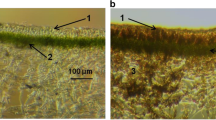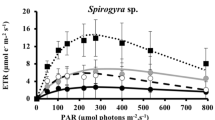Abstract
Exposure of postmitotic growing and non-growing cells of the unicellular green alga Micrasterias denticulata to different UV-B cut-off wavelengths together with simulated sunlight in a sun simulator has revealed a marked resistence of the algae against strong irradiation. While down to a cut-off wavelength of 284 nm irradiated during the most sensitive stage of cell development chloroplast ultrastructure remains unaffected, severe changes in arrangement and structure of stroma and grana thylakoids occur only at the lowest cut-off wavelengths of 280 and 275 nm. The structural alterations end up in a more or less complete desintegration of grana and stroma thylakoids with the remaining membraneous structures appearing in negative staining thus indicating drastic changes in membrane composition. Photosynthetic activity determined by chlorophyll fluorescence (ratio of variable to maximal fluorescence) and oxygen evolution responded more sensitively to UV-B irradiation. With decreasing UV cut-off wavelengths and prolonged incubation a decrease of photochemistry of PS II occured reaching its lowest values after 60 min at 275 and 280 nm. Oxygen production was even maintained under strong UV irradiation with a cut-off wavelenght of 275 nm up to 15 min. With prolonged UV-B treatment any activity was lost. HPLC separations of pigments exhibited the appearance of break-down products (mainly derivatives of chl b and chl a) with decreasing cut-off wavelength and increasing exposure time. The xanthophyll cycle pigments seemed to be unaffected at least for an irradiation period of 60 to 90 min at low UV cut-offs. Possible mechanisms of UV stress avoidance or protection are discussed with regard to the varying altitudes of the natural habitats of the algae.
Similar content being viewed by others
References
Bergweiler, P. & Lütz, C. 1986. Determination of leaf pigments by HPLC after extraction with N,N-Dimethylformamide: ecophysiological applications. Env. Exp. Bot. 26/3: 207–210.
Blumthaler, M., Ambach, W., Silbernagl, R. & Staehelin, J. 1993. Erythemal UV-B irradiance under ozone deficiencies in winter/spring 1993. Photochem. Photobiol. 59: 657–659.
Brook, A. J. 1981. The biology of desmids. Botanical Monographs 16: Blackwell Scientific Publications, Oxford.
Caldwell, M. M. 1971. Solar ultraviolet radiation and the growth and development of higher plants. In: Giese, A. C. (ed.) Photophysiology Vol. 6, pp. 131–177. Academic Press, New York.
Caldwell, M. M., Robberecht, R. & Nowak, R. S. 1982. Differential photosynthetic inhibition by ultraviolet radiation in species from the arctic-alpine life zone. Arctic Alpine Res. 14: 195–202.
Caldwell, M. M. & Flint, S. D. 1994. Stratospheric ozone reduction, solar UV-B radiation and terrestrial ecosystems. Climatic Change 28: 375–394.
Delieu, T. & Walker, D. A. 1972. An improved cathode for measurements of photosynthetic oxygen evolution by isolated chloroplasts. New Phytol. 71: 201–225.
Döhring, T., Köfferlein, M., Thiel, S. & Seidlitz, H. K. 1996. Spectral shaping of artifical UV-B irradiation for vegetation stress research. J. Plant Physiol. 148: 115–119.
Friso, G., Spetea, C., Giacometti, G., Vass, I. & Barbato, R. 1994. Degradation of photosystem II reaction center D-1 protein induced by UVB radiation in isolated thylakoids. Identification and characterization of C-and N-terminal breakdown products. BBA 1184: 78–84.
Garcia-Pichel, F. & Castenholz, W. 1991. Characterizations and biological implications of Scytonemin, a cyanobacterial sheath pigment. J. Phycol. 27: 395–409.
Gold, W. G. & Caldwell, M. M., 1983. The effects of ultraviolet-B radiation on plant competition in terrestrial ecosystems. Physiol. Plant. 58: 435–444.
Häder D. P. & Worrest, R. C. 1991. Effects of enhanced solar ultraviolet radiation on aquatic ecosystems. Photochem. Photobiol. 53: 717–725.
Kallio, P. 1963. The effects of ultraviolet radiation and some chemicals on morphogenesis in Micrasterias. Ann. Acad. Sci. Fenn. 70: 5–39.
Karentz, D., Cleaver, J. E. & Mitchell, D. L. 1991: Cell survival characteristics and molecular responses of antarctic phytoplankton to ultraviolet-B radiation. J. Phycol. 27: 326–341.
Kiermayer, O. 1981. Cytoplasmic basis ofmorphogenesis in Micrasterias, pp. 147–189. In: Kiermayer, O. (ed.), Cytomorphogenesis in plants. Springer-Verlag, Vienna.
Kochevar, I. 1990.UV-induced protein alterations and lipid oxidation in erythrocyte membranes. Photochem. Photobiol. 52: 795–800.
Larcher, W. 1983. Ökophysiologische Konstitutionseigenschaften von Gebirgspflanzen.Ber. Deutsch. Bot. Ges. 96: 73–85.
Lütz, C. 1996. Avoidance of photoinhibition and examples of photodestruction in high alpine Eriophorum. J. Plant Physiol. 148: 120–128.
Madronich, S., McKenzie, R. L., Caldwell, M. M. & Björn, L. O. 1995. Changes in ultraviloet radiation reaching the earth's surface. Ambio 24: 143–152.
Malanga, G. & Puntarulo, S. 1995. Oxidative stress and antioxidant content in Chlorella vulgaris after exposure to ultraviolet-B radiation. Physiol. Plant. 94: 672–679.
Marchant, H. J. 1994. Biological impacts of seasonal ozone depletion, pp. 95–109, In: Hempel, G. (ed.) Antarctic Science. Springer-Verlag, Heidelberg.
Meindl, U. 1993. Micrasterias cells as a model system for research on morphogenesis. Microbiol. Rev. 57: 415–433.
Meindl, U. & Lütz, C. 1996. Effects of UV irradiation on cell development and ultrastructure of the green alga Micrasterias. J. Photochem. Photobiol. B. (In press).
Nossag, J. & Kasprik, W. 1993. The movement of Micrasterias thomasiana (Desmidiaceae, Zygnemtaophyceae) in directed blue light. Phycologia 32: 332–337.
Pfündel, E., Pan, R. & Dilley, R. 1992. Inhibition of violaxanthin deepoxidation by ultraviolet-B radiation in isolated chloroplasts and intact leaves. Plant Physiol. 98: 1372–1380.
Pfündel, E. & Bilger, W. 1994. Regulation and possible function of the violaxanthin cycle. Photosynthesis Res. 42: 89–109.
Ryan, K. G. 1992. UV radiation and photosynthetic production in antarctic sea ice microalgae. J. Photochem. Photobiol. B: Biol. 13: 235–240.
Schlösser, U. 1982. List of strains. Ber. Deutsch. Bot. Ges. 95: 181–206.
Seckmeyer, G., Mayer, B., Erb, R. & Bernhard, G. 1994. UV-B in Germany higher in 1993 than in 1992. Geophys. Res. Lett. 21: 577–580.
Seckmeyer, G. & Payer, H.-D. 1993. A new sunlight simulator for ecological research on plants. J. Photochem. Photobiol. B: Biol. 21: 175–181.
Seidlitz, H. K., Döhring, T., Köfferlein, M., Payer, H.-D., Thiel, S. 1995. Provision ofUVIrradation for Experimental Plant Ecology, pp. 161–164. Proc. Europ. Sympos. on Effects of Environmental UV Radiation. In: Bauer, H. & Nolan, C. (eds) Munich, 27–29 October 1993. EUR 15607 EN, DG, XII, EC Brussels.
Siefermann-Harms, D. 1977. The xanthophyll cycle in higher plants, pp. 218–230. In: Tevini, M. & Lichtenthaler, H. K. (eds) Lipids and lipid polymers in higher plants. Springer, Berlin.
Strasser, R., Srivastava, A. & Govindjee. 1995. Polyphasic chlorophyll a fluorescence transients in plants and cyanobacteria. Photochem. Photobiol. 26: 283–285.
Tevini, M. (ed.) 1993. UV-B radiation and ozone depletion: effects on humans, animals, plants, microorganisms, and materials. Lewis Publ., CRC-press, Boca Raton, USA.
Thiel, S., Döhring, T., Köfferlein, M., Kosak, A., Martin, P. & Seidlitz, H. K. 1996. A phytotron for plant stress research: How far can artifical lighting compare to natural sunlight? J. Plant Physiol. 148: 115–1190.
Wildi, B. & Lütz, C. 1996. Antioxidant composition of selected high alpine plant species from different altitudes. Plant Cell Environ. 19: 138–146.
Ziska, L. H., Teramura, A. H., Sullivan, J. H. & McCoy, A. 1993. Influence of ultraviolet-B (UV-B) radiation on photosynthetic and growth characteristics in field-grown cassava (Manihot esculentum Crantz). Plant Cell Environ. 16: 73–79.
Author information
Authors and Affiliations
Rights and permissions
About this article
Cite this article
Lütz, C., Seidlitz, H.K. & Meindl, U. Physiological and structural changes in the chloroplast of the green alga Micrasterias denticulata induced by UV-B simulation. Plant Ecology 128, 55–64 (1997). https://doi.org/10.1023/A:1009754722357
Issue Date:
DOI: https://doi.org/10.1023/A:1009754722357




